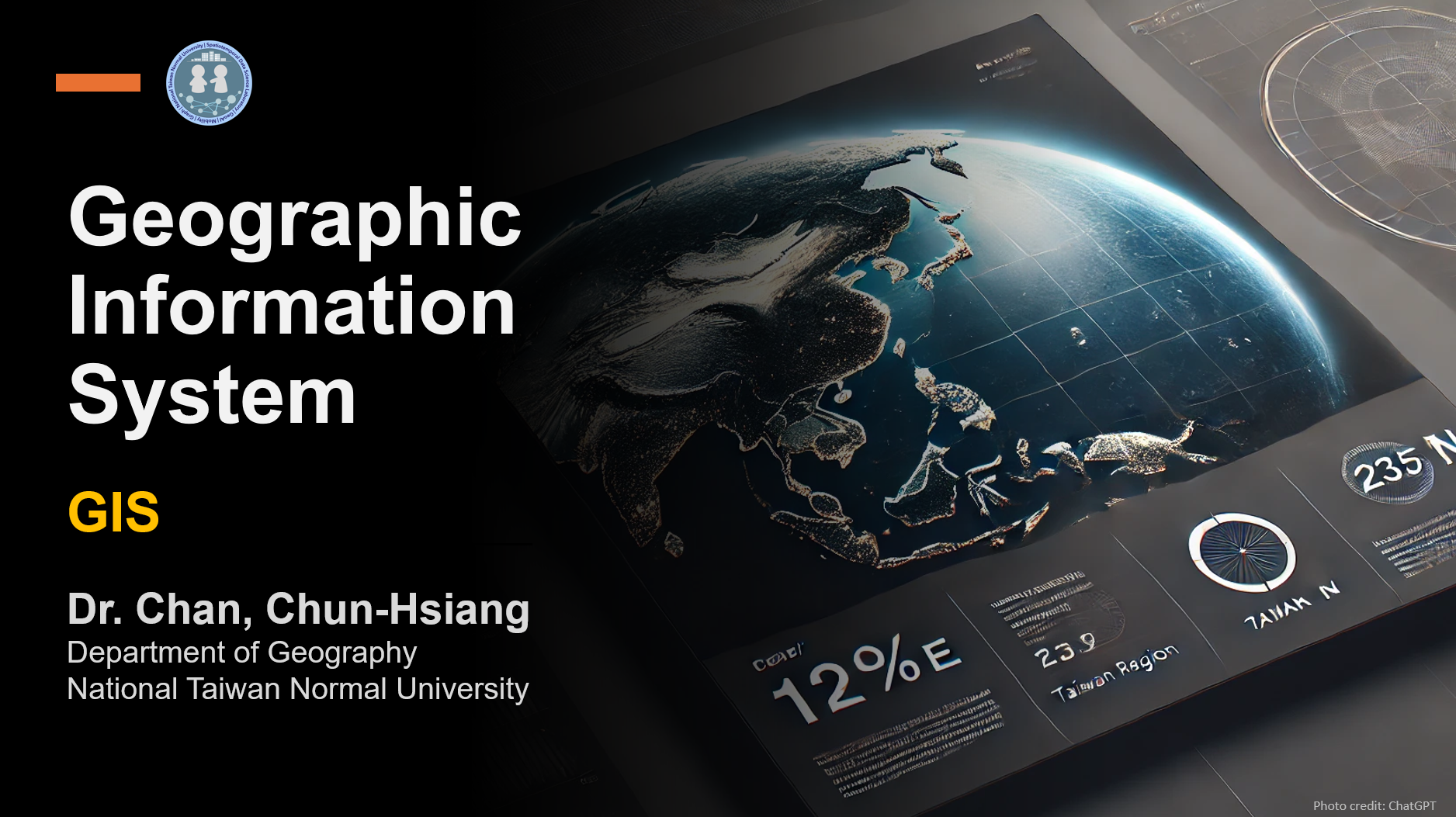Geographic Information System @ NTNU
Course Content
This course introduces basic concepts and tools of geographic information systems (GIS). Theory and frameworks upon which geographic information science is founded are covered where appropriate to provide a context for applied concepts. Lectures will emphasize basic concepts of design, planning and implementation of GIS as they relate to a variety of fields, while the laboratory component will provide hands-on experience with cutting-edge mainstream GIS software. On successful completion of this course, students should be able to understand fundamental concepts of Geographic Information System, and familiarize the usage of current mainstream GIS software. The course consists of tutorials and laboratory sessions. Tutorials are meant to acquaint students with the fundamental concepts and processes in shaping of the land. In particular, a problem-based approach to understanding the violent earth will be adopted through discussions during tutorials.
Course Intro.
 01 :: Course Introduction
01 :: Course Introduction
Contents: (1) About CCH (2) Course Introduction (3) Grading Policy (4) Why do you need to take this course? (5) What will you learn from this course? (6) Textbook & Software
Intro. to GIS & Overview
02 :: Introduction to GIS & OverviewContents: (1) What is GIS? (2) GIS File Elements (3) Types of GIS (4) Download Geo-Datasets (5) An Overview of ArcGIS Pro (6) References
Coordinate System
 03 :: Coordinate System
03 :: Coordinate System
Content: (1) What is a coordinate system? (2) The shape of the Earth (3) GCS and PCS (4) Latitude and longitude (5) Great Circle (6) Projection (7) Common map projections (8) TWD67TM2 and TWD97TM2 (9) What is vector data? (10) Shapefile structure
Vector Data (I)
04 :: Vector Data (I)Content: (1) Display XY (2) Join & Spatial Join (3) Add Field & Data Types (4) Select by Attribute (5) Select by Location (6) Calculate Geometry (7) Calculate Field (8) Symbology
Vector Data (I) :: Lab Practice
04 :: Vector Data (I) :: Lab PracticeContent: (1) Download Datasets (2) Display XY (3) Join & Spatial Join (4) Add Field & Data Types (5) Select by Attribute (6) Select by Location (7) Calculate Geometry (8) Calculate Field (9) Symbology
Vector Data (II)
05 :: Vector Data (II)Content: (1) Extract (Clip/Select) (2) Overlay (Union/Intersect/Identity/Erase) (3) Proximity (Buffer/Near/Create Thiessen Polygon) (4) Dissolve (5) Density (Point/Kernel/Line) (6) Polygon To Line/ Join Features/Feature To Point (7) Symbology
Vector Data (II) :: Lab Practice
05 :: Vector Data (II) :: Lab PracticeContent: (1) Extract (Clip/Select) (2) Overlay (Union/Intersect/Identity/Erase) (3) Proximity (Buffer/Near/Create Thiessen Polygon) (4) Dissolve (5) Density (Point/Kernel/Line) (6) Polygon To Line/ Join Features/Feature To Point (7) Symbology
Invited Talk
 06 :: Google Engineer Speech
06 :: Google Engineer Speech
Content: (1) Cognitive Biases (2) Causal Inference and A/B Test (3) Geographic A/B Test (4) Data Scientist Career
Digitalization
07 :: DigitalizationContent: (1) Usage of Digitalization (2) Digitalization Lab
Midterm Exam
 08 :: Midterm Exam
08 :: Midterm Exam
Content: Midterm Exam
Spatial Interpolation
 09 :: Spatial Interpolation
09 :: Spatial Interpolation
Content: (1) Gridding (2) MAUP (3) Spatial Interpolation (4) Inverse Distance Weighting (5) Kriging (6) Natural Neighbor (7) Spline
Spatial Interpolation :: Lab Practice
 09 :: Spatial Interpolation :: Lab Practice
09 :: Spatial Interpolation :: Lab Practice
Content: (1) Gridding (2) MAUP (3) Spatial Interpolation (4) Inverse Distance Weighting (5) Kriging (6) Natural Neighbor (7) Spline
University Day
 10 :: Holiday
10 :: Holiday
Content: Holiday
Spatial Statistics I
11 :: Spatial ClusteringContent: (1) Spatial Data Distribution (2) Centers (3) Central Tendency Problems (4) z-score and p-value? (5) Average Nearest Neighbor (6) Getis-Ord General G (7) Global Moran’s I (8) Incremental Spatial Autocorrelation (9) k-function
Spatial Statistics I :: Lab Practice
11 :: Spatial Clustering :: Lab PracticeContent: (1) Centers (2) Average Nearest Neighbor (3) Incremental Spatial Autocorrelation (4) Getis-Ord General G (5) Repley’s k-function (6) Global Moran’s I
Spatial Statistics II
12 :: Spatial Statistics IIContent: (1) Global vs Local Patterns (2) A Local View (3) Local Moran’s I (4) Getis-Ord Gi* (5) Density-based Clustering (6) Spatial Outlier Detection (7) False Discovery Rate Correction (8) Multivariate Clustering (9) ML Clustering
Spatial Statistics II :: Lab Practice
12 :: Spatial Statistics II :: Lab PracticeContent: (1) Identify the Spatial Distribution of Clusters (2) Group the Village with Similar Demographic Attributes
Raster Data
 13 :: Raster Data
13 :: Raster Data
Content: (1) What is Raster Data? (2) Satellite Images (3) Raster Information (4) Vector & Raster Conversion (5) Map Algebra (6) Contour (7) Layout (8) References
Zonal Statistics
 14 :: Zonal Statistics
14 :: Zonal Statistics
Content: (1) Mosaic To New Raster (2) Contour (3) Hillshade (4) Slope (5) Viewshed (6) Zonal Statistics (7) Map Layout
Zonal Statistics :: Lab Practice
 14 :: Zonal Statistics :: Lab Practice
14 :: Zonal Statistics :: Lab Practice
Content: (1) Mosaic To New Raster (2) Contour (3) Hillshade (4) Slope (5) Viewshed (6) Zonal Statistics (7) Map Layout
Review
 15 :: Review
15 :: Review
Content: ---
Final Exam
 16 :: Final Exam
16 :: Final Exam
Content: Final Exam